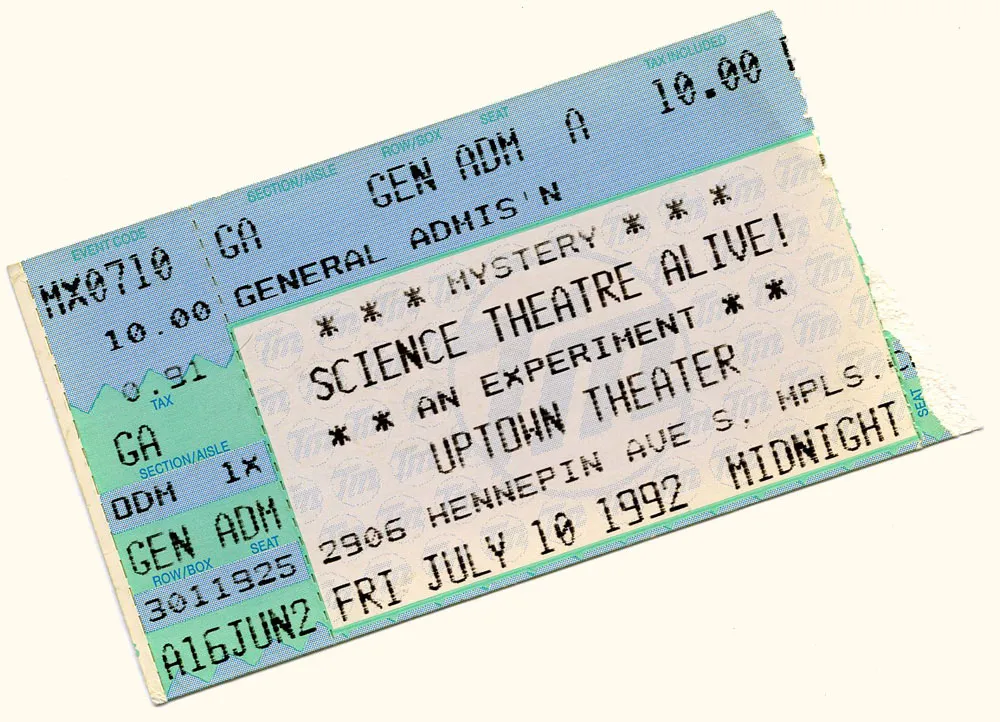
After last night’s geeky Star Trek post, fellow type designer Jackson Cavanaugh suggested on Twitter that I share some of my stories about Mystery Science Theater 3000, the cult comedy TV show from the nineties (and slightly earlier). Great suggestion, Jackson!
I was going to start tonight, but I was busy attending a Type Tuesday event this evening. (Type Tuesday is a monthly get-together of type aficionados in the Minneapolis/St. Paul area.)
In the mean time, above is something from my scrapbook: A ticket stub from the first MST3K live show, performed at the Uptown Theater in Minneapolis in 1992. All I will say about it is, my face ached from laughing.
More tomorrow.
Warning: If you don’t like or care about Star Trek, I understand. Feel free to skip this.
It all started about two months ago, when the J.J. Abrams Star Trek movie (2009) rose to the top of my NetFlix queue. (I wrote about this movie for using one of my fonts back when it was in theaters.) I’ve become somewhat of a Blu Ray fan and thought this would be a fun movie to watch in that format. I was right. I think I like it even more now than when I first saw it.
One thing led to another and before I knew it, I had purchased the two sets of Star Trek movies on Blu Ray. For some reason, I was never really that interested in watching these on DVD. I tried watching the first one (Star Trek: The Motion Picture) once, but couldn’t get through the first 20 minutes. The picture and sound were just horrible. I think it must have been an early DVD release, the kind where it’s not optimized for wide screen viewing.
I’d seen both Star Trek II: The Wrath of Khan and Star Trek IV: The Voyage Home more than once (both considered among the best of the series). The rest I only saw in the theater, except for Star Trek: Nemesis, which I’d never seen at all.
So, with some trepidation, I subjected myself to a Star Trek movie marathon over the last couple of weeks. It was interesting. The movies were both better and worse than I remembered.
Star Trek: The Motion Picture. This is my least favorite of the entire series. It was a disappointment when I saw it in the theater in 1979. Slow, overblown, ridiculous and terrible in so many ways. You get the feeling that the special “V’GER” effects were expected to carry the movie by themselves, but it just looks like self-indulgent nonsense, and adds little to the story. If anything, this movie was worse than I remembered. The titles are dull and feature that goofy Star Trek Movie font. I didn’t like then, and I don’t like now.
Star Trek II: The Wrath of Khan. Considered by most to be the best Star Trek movie ever. I don’t really disagree with that, but I don’t think it has aged well. It was one of the earliest movies to feature computer graphics, and it looks it. The whole production feels kind of like a disco nightmare, but the chemistry of the characters and the story make it really entertaining.
Star Trek III: The Search for Spock. Better then I remembered. Very cheesy special effects and preposterous story. Worth watching just to see Kirk and friends blow up the Enterprise and steal a Klingon ship.
Star Trek IV: The Voyage Home. Cool because they still have the Klingon ship and—even better—take it back in time to the 1986 San Francisco. Funniest of all the Star Trek movies, but, again, the story is a little preposterous. Getting a little repetitious: Big mysterious thing threatens Earth, just like the first movie.
Star Trek V: The Final Frontier. On second thought, maybe this is my least favorite. Most preposterous story of all, but it looks better than any of the previous films. The center of the galaxy is much smaller than I expected. Silliest and most forgettable of the series.
Star Trek VI: The Undiscovered Country. Better than I remembered. The story is not bad: The incident that leads to peace with the Klingons. Some nice zero-gravity effects. A little too much Shakespeare from the Klingon played by Christopher Plummer.
Star Trek: Generations. This is not considered one of the best, but I like it. The production values are higher than the earlier films. I also think the Next Generation cast are, on average better, actors than the earlier cast. At least Stewart is. I love the scene in which, after narrowly winning a battle with a Klingon ship, they are forced to crash land the Enterprise. And then the planet blows up, killing everyone. This can only mean another time travel plot. This one also has the most tastefully-done titles in the series, in spite of being set in ITC Benguiat.
Star Trek: First Contact. This is generally considered to be the best of the Next Generation movies, but it was not as good as I remembered. Good: It has The Borg. Bad: More time travel, and James Cromwell as the guy who invents “warp drive”. I usually like Cromwell, but he seems mis-cast in this. Titles use Benguiat again, but look terrible.
Star Trek: Insurrection. Last one I saw in the theaters before the re-boot. I couldn’t have told you what it was about until seeing it again. Not very good, but not really terrible either. Would have made a good two-part episode on the TV show. Worst titles of the series—very cheap looking.
Star Trek: Nemesis. This is the one I’d never seen before. It is supposed to be one of the worst of the series, so I expected not to like it. But I actually kind of liked it. Some of it is goofy, but that’s par for the course in the Star Trek universe. The battle at the end was pretty good. The dune buggy scenes were inexplicable, but fun. The titles were set in Exocet, I think. Seemed very dated.
1976: One hour by bus from Osseo (an outer-ring suburb) into downtown Minneapolis.
1977: Half hour by car from Osseo into downtown Minneapolis.
1977: Twenty minutes by bus from Saint Louis Park (an inner-ring suburb) into downtown Minneapolis.
1979: Fifteen minutes by car from Saint Louis Park to Saint Paul.
1981: Twelve minutes by car from South Minneapolis to downtown Saint Paul.
1985: Ten minutes by car from South Minneapolis to South Minneapolis.
1992: Five minutes by car from Saint Paul to Saint Paul.
2000–Present: Under one minute on foot (working at home).
I don’t understand why people put up with long commutes.
This entry is probably going to date me quite a bit. What I consider to be my first real computer was the Atari 400, which I bought in 1982. Around a year later, I got an Atari 800, mainly so I could type on a real keyboard. (The 400 had a cheaper “membrane” keyboard, which gave little tactile feedback. To make up for this, you would hear an audible “click” from the speaker. Not very different from modern touch-screen keyboards, now that I think of it.)
I still had both of them until about a year ago when I donated them to a local Atari dealer. Yes—they still exist! Not only that, one of the local Atari user groups that was around back in the early eighties (S.P.A.C.E.: Saint Paul Atari Computer Enthusiasts) still meets once a month less than a mile from my home!
Anyway, before I unloaded them, I took some photos. Here is the 400, with its membrane keyboard:
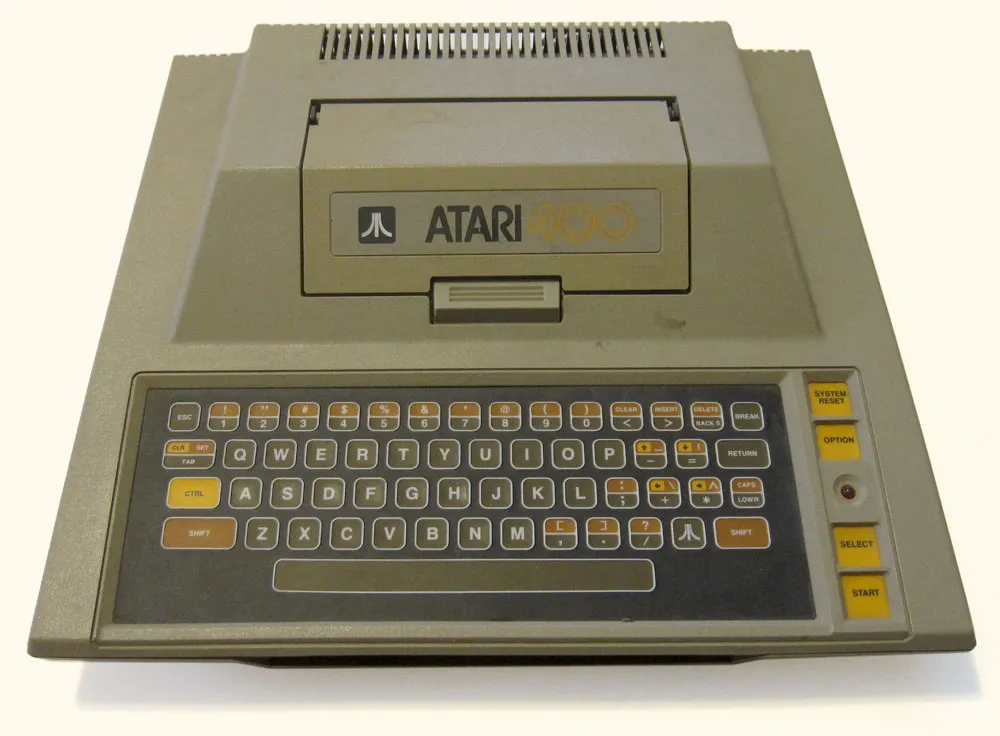

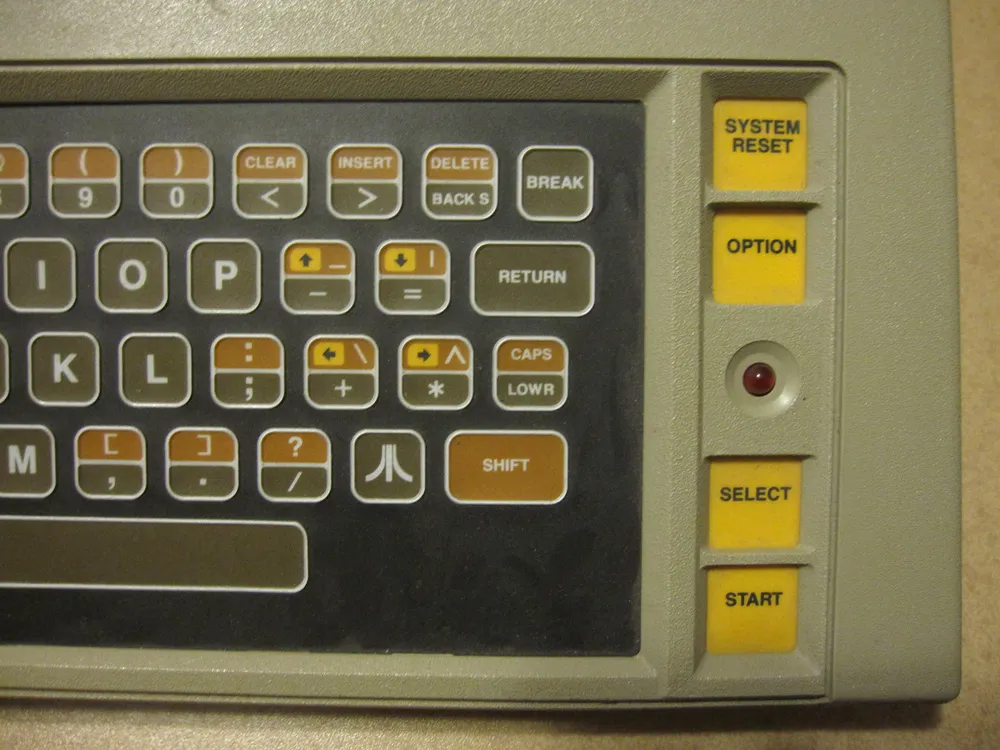
It sported a 1.79 Mhz 6502 processor, the same kind that was in the Apple II. Unlike the Apple II, it had a dedicated graphics processor and built-in sound chip, and four joystick ports, so it was a lot better for games. (A few years later, the guy who designed these computers designed the Amiga, which had a similar hardware concept.) Many programs (especially games) came on cartridges that you inserted into a slot under the access door on top. It had 16k of RAM, but I upgraded mine to 48k.
I also got a cassette “program recorder” so I could save and load files. I got the home computer bug really bad, so it wasn’t long before I upgraded to a floppy disk drive and then the Atari 800 model, which had a real keyboard, a composite video output for better picture, and a mostly useless second cartridge slot:

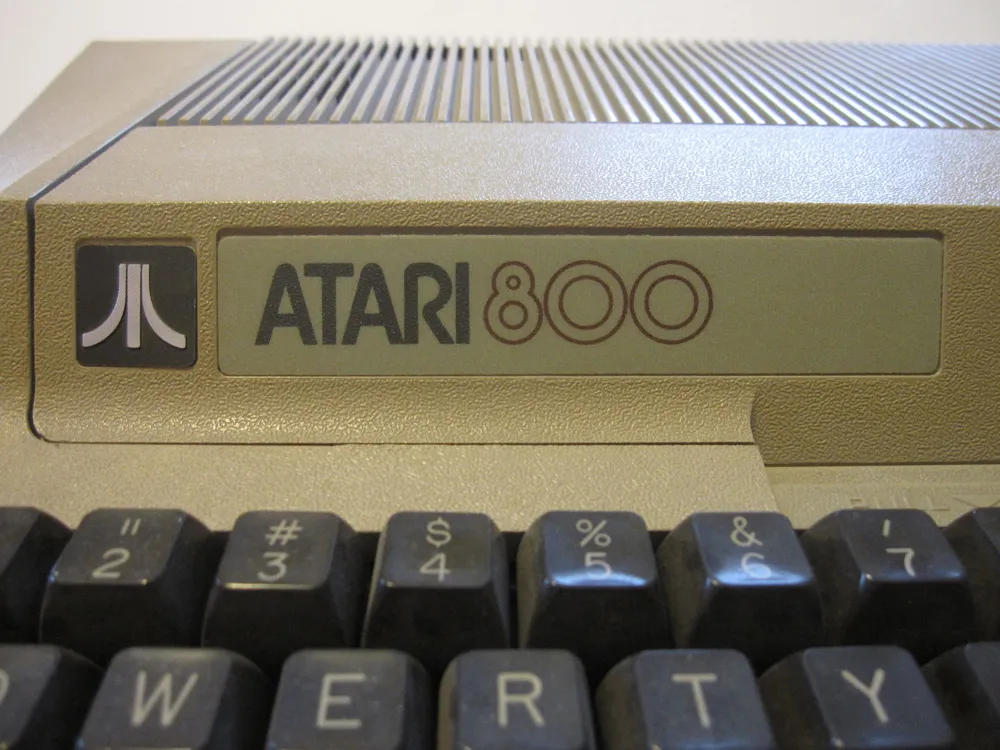
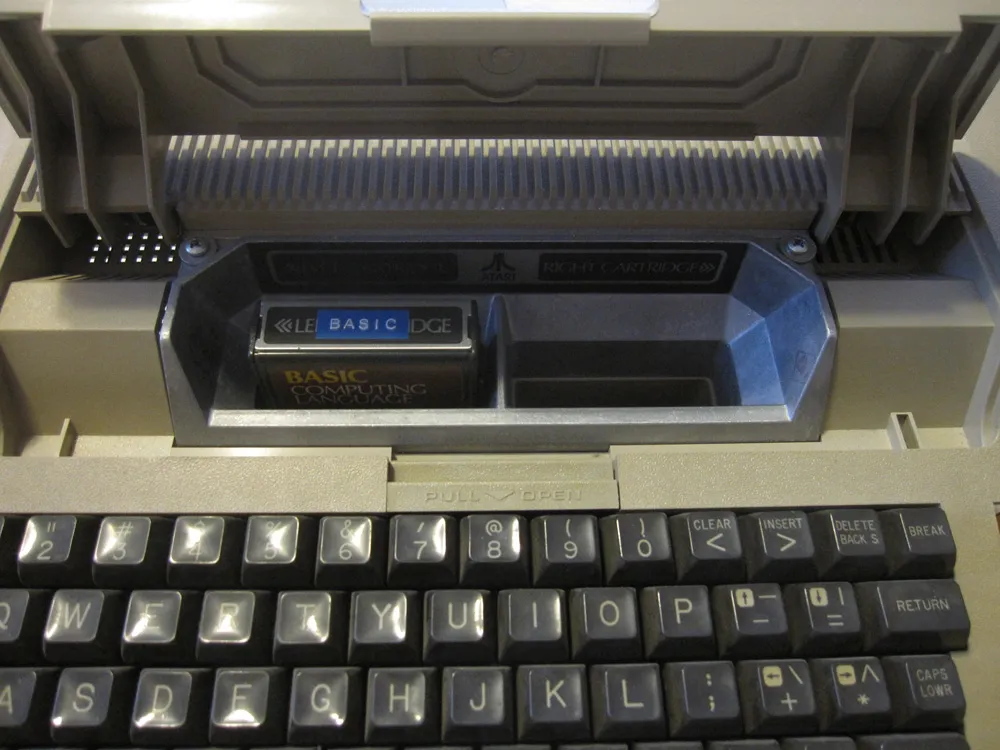
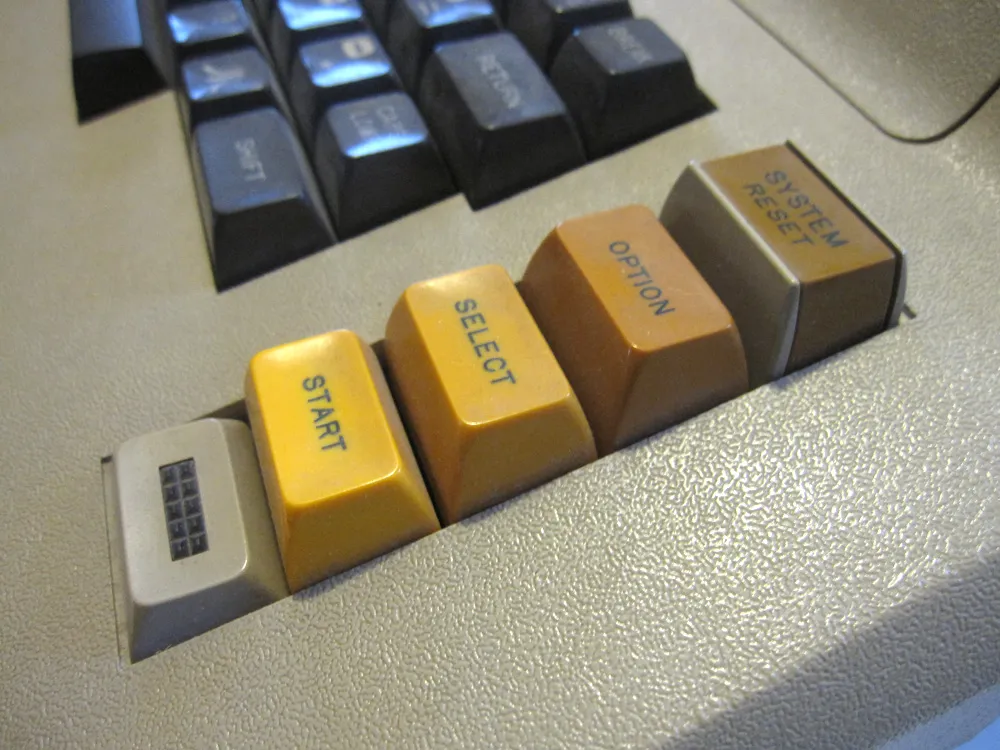
In spite of the fact that it had a real keyboard, it still did the fake “click” sound like the 400 from the speaker when you typed. This lead me to do my one and only hardware hack on it: I added a small switch underneath which cut out the speaker. If it got too annoying, I could switch off the sound.

These were the days before the internet and—really—almost everything we use computers for now. So, what did I use my Atari for? Mostly, I played games (Star Raiders was amazing, but also a lot of Defender, Joust, and some of the early Lucasfilm games) and typed in BASIC programs from computer magazines. I also wrote an article for a magazine on it once and did some “computer” illustrations that were published in real magazines. Learning about programming was the most useful thing about it in the long run—a very good thing to know when making fonts.
Just for fun, I took a photo of one of my current computers, a MacBook Air, next to the Atari 800:
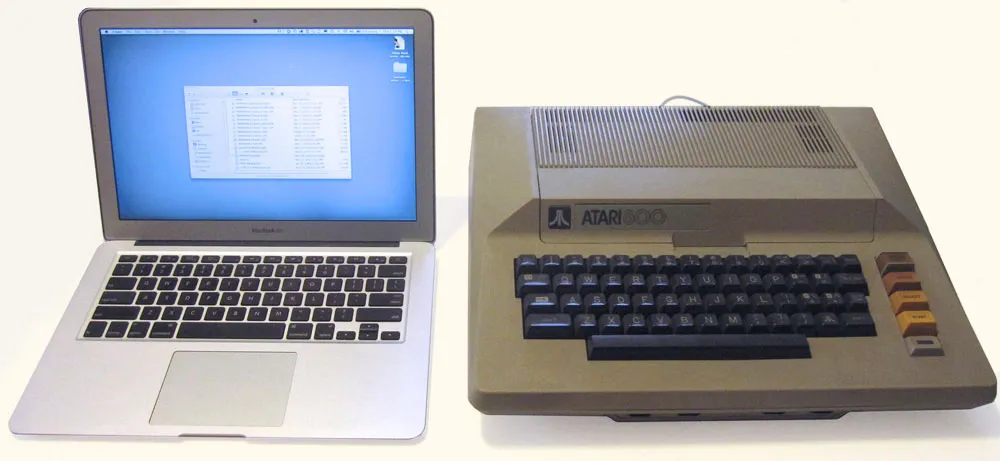
The Air is about 1000 times as fast, has about 100,000 times as much RAM, can store as much data as 1.3 million Atari 88K disks, a built-in flat display with 21 times the pixel density, can display a million times as many colors, has high-speed wireless networking connected to millions of other computers around the world, can run for 10 hours on its built-in rechargeable battery, and is a tiny fraction of the 800’s size and weight, including the display. Not bad for 30 years progress. On the other hand, the Air is conceptually not very different from the first Mac I bought in 1984, a little over two years after I bought my Atari 400.

We live a few blocks from the Minnesota State Fairgrounds, and every summer the “Back to the Fifties” car show is held there. There’s usually no need to actually pay to get into it to see the cars—our neighborhood is full of them, cruising around, for the duration of the show. But lately I’ve paid to get in, mainly to get shots of the nameplates, or “brightwork” as it is known.
The Chevy “Bel Air” nameplate, from the late-fifties, is my all-time favorite. The design is so simple and stylish. (Photo taken in Saint Paul, Minnesota, June 20, 2009.)
There might be a personal bias to my “Bel Air” preference. We always had Chevys when I was a kid, a ’59 Bel Air and a ’64 Bel Air—the car I learned to drive on and the car I drove during high school in the early seventies. Here’s a cartoon painting I did of it back then as a joke:
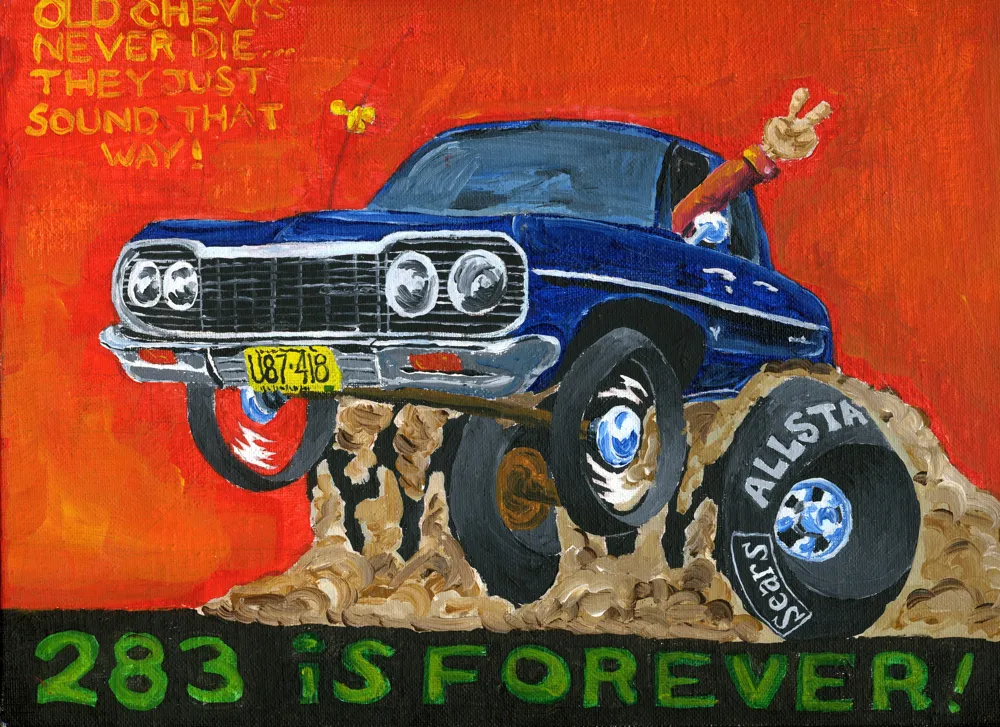
(When I was in high school, I had a little side business doing cartoon drawings of cars like this for my friends. I’ll post more of them sometime.)
One more follow up on the item I posted last week, in which I mentioned my uncle Knut who worked as a designer at Container Corporation of America…. After I posted that, Knut sent me a photo of the cookie package he designed:
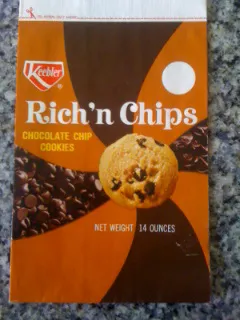
This was (I believe) one of the first packages for Keebler chocolate chip cookies, and my uncle’s first printed package design. It debuted in July 1967. It seems so tasteful and restrained compared to the modern equivalent.
I was very impressed by this as a budding artist. It put into my mind the notion that, if you were good, your work could be seen by millions of people. Definitely something I was attracted to very early on, and probably something a lot of artists and designers can relate to.
